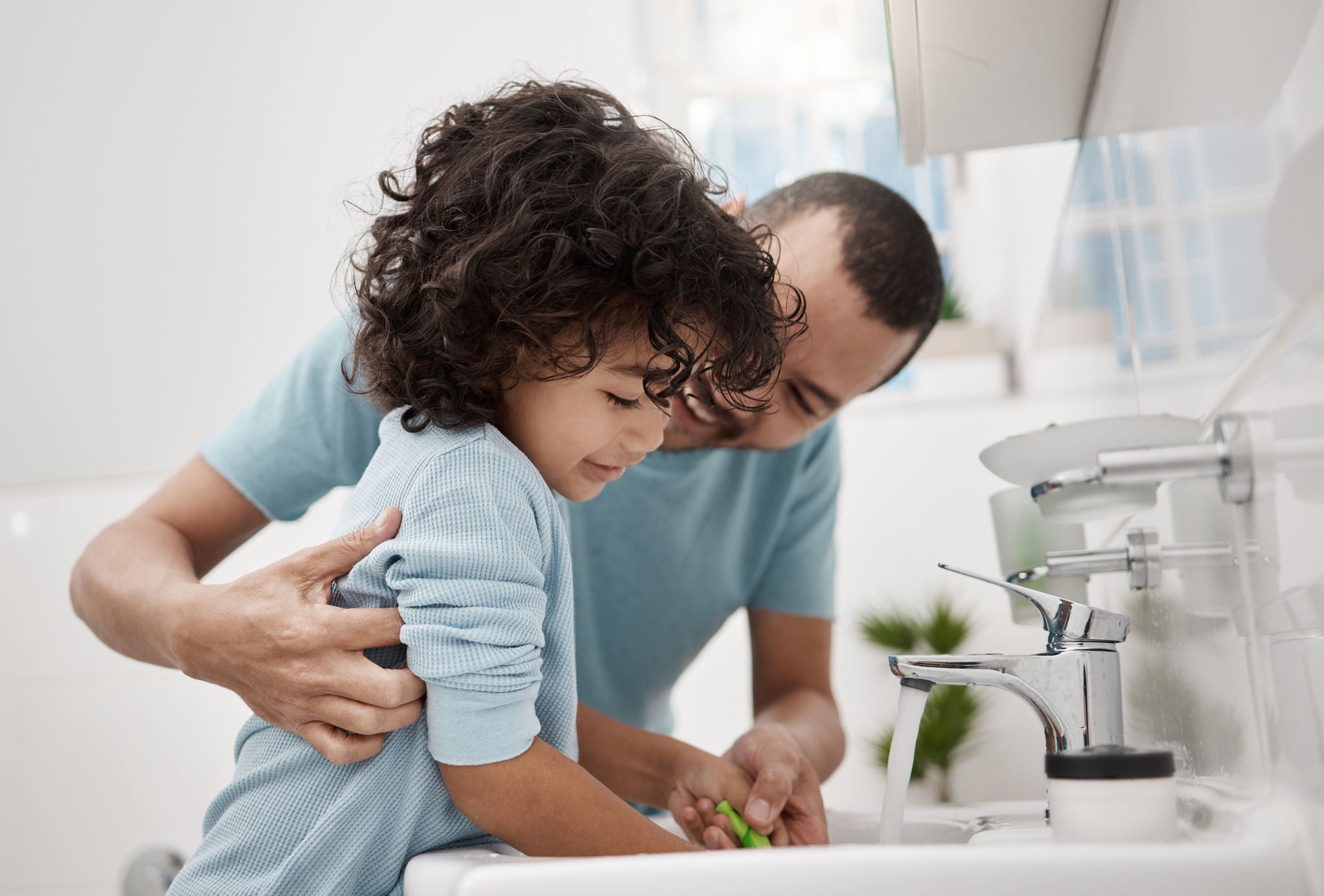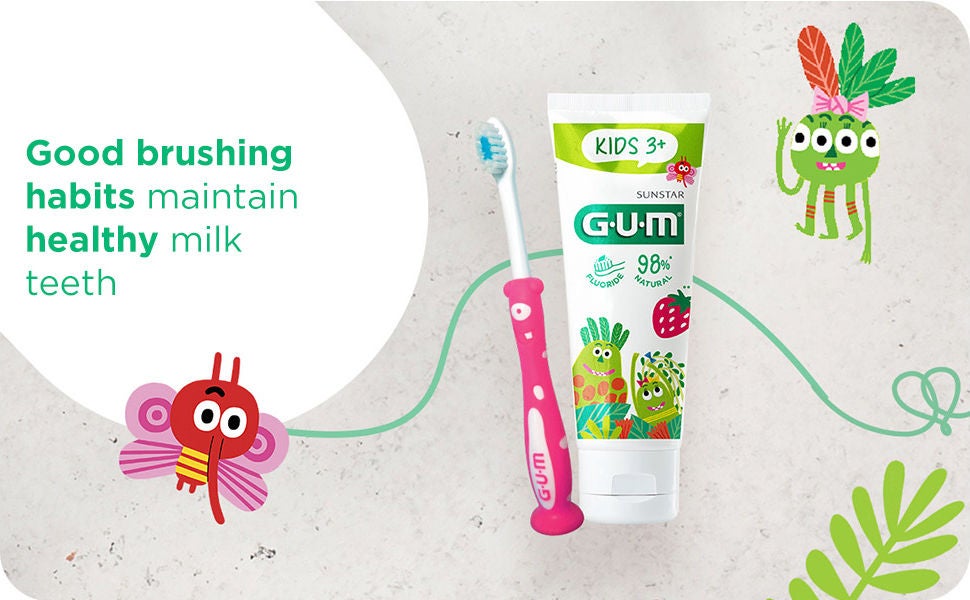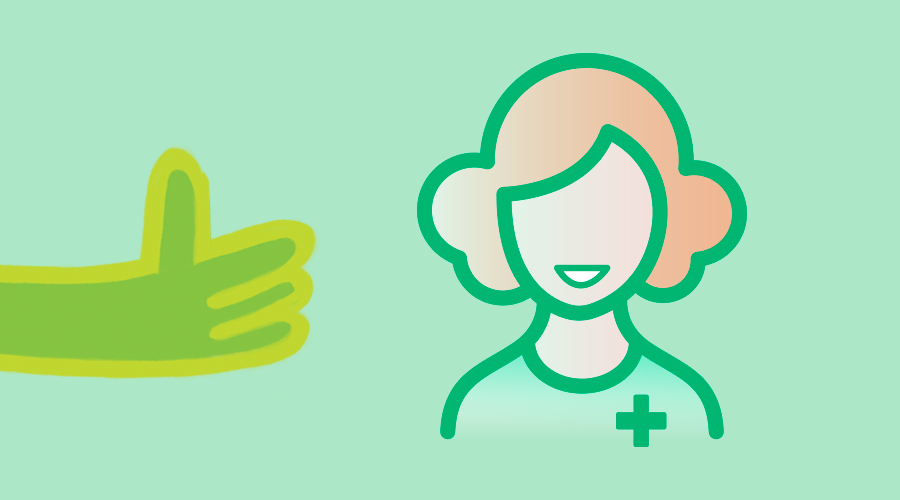
When Can Kids Use Adult Toothpaste?
Children don’t come with instruction manuals. The good news is that it is easier than ever to connect with experts who can help ensure that you’re on the right track with your child’s care and development.

A significant part of that care is teaching your child proper oral hygiene so they can enjoy lifelong oral health. This is one of our greatest passions at SUNSTAR GUM®.
That’s why we’ve put together this Q&A with our team of experts answering your questions about when a child can graduate to using adult toothpaste.
Our expert answers your questions about kids and toothpaste

Yes, there is a difference, and it is mainly in the quantity of fluoride the toothpaste contains. As children grow through different developmental stages with their teeth, the quantity of fluoride they need will also differ.
Why do fluoride levels matter? In excess, fluoride can actually be harmful to tooth formation. Too much consumption of fluoride can lead to a condition known as fluorosis, which causes fragile and discoloured spots in tooth enamel.
The other significant differences between kids and adult toothpaste have more to do with creating an enjoyable experience for children that promotes positive associations with oral care. Kids may not appreciate the strong mint flavours and more abrasive textures often found in adult toothpaste. Instead, they tend to favour things like fun flavours (such as strawberry) and gel-like textures.
Fluoride strengthens tooth enamel by integrating with the tooth’s crystalline structure. This defends teeth against acid attacks caused by bacteria in the mouth, as well as acids found in certain foods and drinks.
Children who can’t spit yet will swallow most of the toothpaste, ingesting the fluoride and increasing their risk of fluorosis.
Fluorosis occurs when too much fluoride is incorporated into the enamel structure of the tooth, to the point that it actually renders the structure fragile instead of strengthening it. This condition can also lead to spotty discoloration that appears white to brown.
Knowing that adult toothpastes contain more fluoride than children’s toothpaste (see question 5), fluorosis is therefore a risk if children use adult toothpaste.
Too much of any substance can be harmful. This is true of everything you consume, including water. However, there is no risk when using the prescribed amount of fluoride in the correct manner.
At the doses used in toothpaste, fluoride is not toxic. And if used in the right quantity according to age (we’ll discuss that in more detail shortly), topical fluoride is beneficial to oral health to prevent cavities and is recommended by both scientific societies and various government policies as the easiest, most efficient and evidenced preventative measure to combat cavities (when used in tandem with brushing).
In dentistry, we measure the quantity of fluoride in toothpaste as parts per million of fluoride (ppmF). The packaging of your toothpaste should indicate the ppmF.
Based on a twice-daily brushing habit, the quantity of fluoride in the toothpaste should be as follows, according to the European Academy of Paediatric Dentistry (EAPD):
- Children, from first tooth up to two years of age: 1000ppmF
- Children from ages two to six : 1000ppmF
If the quantity of fluoride is the same between the first tooth up to 2 years of age and between 2 and 6, the difference resides in the quantity of toothpaste put on the toothbrush (see question 6).
- Children over 6 years of age: 1450ppmF
Adults should generally use toothpaste that contains 1450ppmF. Toothpastes with more ppmF may be prescribed by the dentist when there is a high risk of developing cavities (dental caries).
Based on a twice-daily brushing habit with a fluoride amount in the toothpaste adapted to the age of the child (see question 5), the size of the toothpaste dab on the brush should be as follows, per EAPD:
- Children, from first tooth up to two years of age: Equal to a grain of rice
- Children from ages two to six: Equal to a pea
- Children over 6 years of age: Up to the full length of the brush.
Don’t forget: Due to the small size of their mouths and developing dexterity, children require specialised toothbrushes as well.
This depends on the quantity of fluoride in the toothpaste, quantity of toothpaste on the toothbrush, and the child’s level of risk for developing cavities. If you are uncertain, consult with your child’s dentist to discuss when to make the transition.
First and foremost, make sure you are choosing a toothpaste with the correct amount of fluoride for your child’s age. After that, be sure to work with your child to find a toothpaste that has a pleasant flavour and texture, so the toothpaste itself makes brushing an enjoyable experience. Again, if you have any questions, be sure to ask your child’s dentist for their recommendations.
Twice-daily brushing to remove plaque is the cornerstone of good oral hygiene. In addition to this, starting to teach your child how to properly use interdental cleaning tools, if possible, will help them develop strong oral hygiene habits. This is especially important if your child undergoes orthodontic treatment.
Helping your child establish good eating habits is also important for life-long oral health – and whole-body health. The mouth and the rest of the body are intricately linked, and nutrition that helps your body stay strong can often have a positive impact on oral health as well.
Teach moderation and reduce your child’s consumption of sugars and acidic foods and drinks. Help them find foods high in fibre that they enjoy eating. Avoid processed foods, and encourage daily physical activity from a young age.
